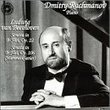| All Artists: Busoni, Beethoven, Dorfman Title: Indian Diary / Sonata 30 in E Op 109 Members Wishing: 0 Total Copies: 0 Label: A.W. Promotions Release Date: 11/24/1998 Genre: Classical Styles: Forms & Genres, Sonatas, Historical Periods, Classical (c.1770-1830), Romantic (c.1820-1910), Symphonies Number of Discs: 1 SwapaCD Credits: 1 UPC: 764942880327 |
Search - Busoni, Beethoven, Dorfman :: Indian Diary / Sonata 30 in E Op 109
 | Busoni, Beethoven, Dorfman Indian Diary / Sonata 30 in E Op 109 Genre: Classical
|
Larger Image |
CD DetailsSimilar CDs |
CD ReviewsTechnical expertise plus warmth and humanity 07/06/1999 (5 out of 5 stars) "Fans of high-powered piano playing would do well to check out "Geoffrey Dorfman, pianist," a new recital disc in which the pianist plays one of the late, great Beethoven sonatas and show his chops with works by twentieth-century composers/virtuosos Sergei Rachmaninov and Ferruccio Busoni. The program gets off to a good start with Busoni's rarely heard "Indian Diary" - four microscopic tone poems depicting life among Native Americans. From the hopping rhythms and cascading scales of the "Corn Blossom Song" to the tender longings of "the Bluebird Song", Dorfman shows technical expertise while bringing out the warmth and humanity in Busoni's complex music. Rachmaninov was one of the last great pianist/composers. Here he is represented by a selection of preludes - most notably the sonorous no.10 in b minor and the delicate and refined no. 5 in G major. Although Dorfman seems less comfortable playing the Rachmaninov-the music doesn't flow as naturally from his fingers as it does elsewhere on the set - these are noble performances. Finally, Dorfman tackles one of Beethoven's notoriously difficult late sonatas, his 109 in E Major. The two tight, densely constructed movements whiz by, with Dorfman doing his best to prove the relationship between this oddly shaped sonata and Bach's "Well-Tempered Clavier." In the final movement, a long set of variations, Dorfman plays with lyricism, grace, and a sense of form. All in all, an impressive recording from a pianist worth investigating. Paul J. Pelkonen, Classical Editor newyorkcitysearch.com/september 1998" Authoritative playing 07/06/1999 (5 out of 5 stars) "Although Geoffrey Dorfman had taken piano lessons as a child, he had a substantial career as a painter before he returned, a decade ago at the age of 37, to a serious study of the instrument. But you'd never guess, from these performances that he was more or less a latecomer: this is authoritative playing, both technically assured (nothing on this challenging program seems to strain his fingers) and interpretively individual. What's most notable is his chiseled clarity. Although he's apt to employ the kind of generous rubato usually associated with a rich sound, he's sparing of the pedal and chary of legato, producing dry and sharply articulated readings that fasten on the music's rhythmic details and textural balances (try the play of voices in Rachmaninov's op.23/6) rather than its timbres and harmonic colorations. Thus, for instance, in the snappy reading of the second movement of the Beethoven, his left hand provides clarity and definition rather than weight; and while he's surely sensitive to the impressionistic qualities in the last movement of Busoni's Indian Diary and to the sparkle of the second variation in the finale of the Beethoven, he sometimes contracts the music's dynamic range in pursuit of vertical clarity. This approach has the most striking consequences in the Bach-Busoni Chaconne: eschewing the full, organlike sonority preferred by so many pianists, Dorfman chips away at the music, providing a spiky surface that lays bare the music's inticate contrapuntal workings. Except for some overload, the sound is good: and the pianist's sometimes bizarre liner notes are not a serious detriment. Well worth your attention. Peter J. Rabinowitz, FANFARE Magazine November-December 1998"
|

 Track Listings (15) - Disc #1
Track Listings (15) - Disc #1